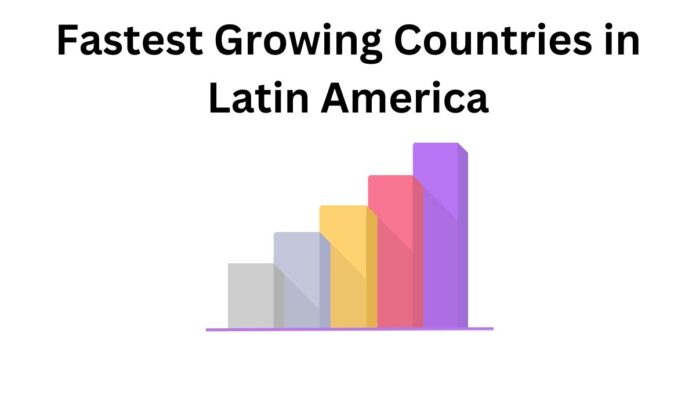In this article, we will explore the top fastest-growing countries in Latin America: Invest in 2023.
The past few years have been a rollercoaster for the entire world. Think back to 2019, the last time things felt somewhat “normal.” Since then, global crises seem to have become a regular occurrence. First, COVID-19 rattled economies and forced lockdowns, disrupting everyday life and business. Just as we began to see a glimmer of recovery, the Russian-Ukraine conflict sent shockwaves through energy and food supply chains.
Fast forward to 2023, and it’s clear that this year will be pivotal, especially for economies still grappling with the ripple effects of the Ukraine conflict. The U.S. is stuck in a tug-of-war between surging inflation and stagnant growth. On the flip side, Latin America, though facing its own challenges, seems to be showing resilience.
A snapshot of 2022 reveals that Latin America did reasonably well compared to other regions. Deloitte highlighted that Latin America’s GDP bounced back, surpassing its pre-pandemic growth levels in 2021. However, they do caution that the economic woes of the U.S. and Europe could cast shadows over Latin America’s progress.
Why? Well, Latin America is intrinsically connected to global markets. Consider Brazil, a major producer of coffee, or Mexico, which heavily relies on U.S. demand for goods like vehicles. When the U.S. economy sneezes, Latin America feels the cold. Deloitte even revised down its growth forecast for Latin America to 1.7% this year.
Inflation, the tricky monster that it is, isn’t just a U.S. problem; it’s tightening its grip on Latin America too. Coupled with the Federal Reserve’s monetary policy moves, local currencies in the region are feeling the heat. Additionally, data suggests that capital inflow into the region and debt issuances are on the decline.
But it’s not all doom and gloom. While economic challenges persist, S&P Global sees potential business opportunities, thanks to the U.S.-China rivalry and the burgeoning renewable energy sector.
Speaking of renewable energy, Latin America has a unique proposition. The OECD points out that the region is more susceptible to the adverse effects of climate change. But on the brighter side, Latin America is ahead in the renewable energy game, producing double the global average. Embracing this sector could lead to job creation and might be a silver bullet for some of the economic issues faced by the region.
So, which countries in Latin America are leading the growth chart? You might be surprised. The giants, Brazil and Mexico, aren’t topping the list. Sometimes, the most significant players aren’t the fastest growers, and that seems to be the story here. Let’s dive in and find out who these rising stars are.
Our Approach and Methods
To put together our list, we turned to the International Monetary Fund (IMF), a reliable source when it comes to global economic data. Why? Well, the IMF is tasked with helping nations navigate financial challenges, preventing major economic meltdowns. We sourced our growth figures from the IMF’s World Economic Outlook report, released in October 2022. And just a heads-up, all the GDP numbers we’re mentioning are based on purchasing power parity estimates.
1. Co‑operative Republic of Guyana
2023 Projected Real GDP Growth Rate According to IMF: 25.2%
Guyana, formally known as The Co‑operative Republic of Guyana, is a gem nestled in South America. While English is its primary language, the nation’s economic landscape is intriguing. With a GDP standing around $30 billion, it might seem modest on a global scale. Yet, when you break it down per person, the GDP per capita is a robust $38,258. The country’s main exports include ships, containers, machinery, gold, and aluminum, all contributing to its foreign exchange earnings.
2. Bolivarian Republic of Venezuela
2023 Projected Real GDP Growth Rate According to IMF: 6.5%
Venezuela, officially known as The Bolivarian Republic of Venezuela, is a picturesque coastal nation in South America. Despite its natural beauty, the country faces significant economic challenges with a per capita income of just $7,108. Over the years, Venezuela has grappled with political unrest, including riots and revolutions. This instability has weighed heavily on its industries. The nation primarily relies on oil exports for its foreign exchange revenue. Moreover, corruption remains a significant concern. In 2022, Transparency International’s Corruption Index ranked Venezuela 177 out of 180 countries, marking it as the most challenging spot in the Latin American region.
3. Dominican Republic
2023 Projected Real GDP Growth Rate According to IMF: 4.5%
Nestled in the Greater Antilles archipelago of the Caribbean, the Dominican Republic boasts a vibrant economy with a GDP reaching $254 billion. This translates to a commendable per capita income of $23,983 for its residents. The nation’s export palette is quite diverse, featuring a mix of gold, tobacco, medical instruments, and more. Notably, the U.S. stands out as the Dominican Republic’s main trading ally, responsible for roughly half of its trade activities, both in terms of imports and exports.
4. Republic of Paraguay
2023 Projected Real GDP Growth Rate According to IMF: 4.3%
Nestled in South America, the Republic of Paraguay stands out as one of the unique countries globally that relies entirely on renewable sources for its electricity. With a GDP of $108 billion, its residents enjoy a per capita income of $14,528. Beyond just producing green energy for its own use, Paraguay has carved out a niche for itself as one of Latin America’s top electricity exporters. This not only underscores its commitment to sustainability but also serves as a significant source of foreign exchange revenue.
(Note: The original text mentioned “Uruguay,” but the rest of the information seemed to pertain to Paraguay. I made the assumption that “Paraguay” was the intended focus and made corrections accordingly.)
5. Oriental Republic of Uruguay
2023 Projected Real GDP Growth Rate According to IMF: 3.6%
Situated in South America, Uruguay boasts a GDP of $96 billion and stands out as one of the globe’s most peaceful and forward-thinking nations. While it has a diverse export portfolio, it leans heavily on its food and agricultural sectors, with beef taking the top spot. Other major exports include malt, rice, and wood pulp. Interestingly, China plays a pivotal role in Uruguay’s trade, being both its largest source of imports and its biggest export destination.
6. Republic of Honduras
2023 Projected Real GDP Growth Rate According to IMF: 3.5%
Honduras, a charming Central American country, unfortunately ranks among the world’s less affluent nations with its GDP standing at $30.5 billion. A significant chunk of its export pie is textiles, making up more than a third of its total exported goods. And when it comes to trading, the U.S. stands out as Honduras’ top buddy, being its primary import and export ally.
7. Plurinational State of Bolivia
2023 Projected Real GDP Growth Rate According to IMF: 3.2%
Bolivia, often referred to as the Plurinational State of Bolivia, sits in the heart of South America and boasts a GDP of $118 billion. It’s a land rich in natural resources, with mining anchoring its economy. In fact, over half of what Bolivia produces comes straight from beneath its soil, including treasures like gold, oil, zinc, and lead. As for its global trading scene, Brazil and China top the list as Bolivia’s main business partners.
8. Republic of Guatemala
2023 Projected Real GDP Growth Rate According to IMF: 3.2%
Nestled in Central America and sharing its northern border with Mexico, we find the vibrant Republic of Guatemala. With a GDP of $185 billion and an average income of $4,880 per person, Guatemala’s heart beats to an agricultural rhythm. A major part of its economy lies in its bountiful exports of delicious goods like bananas, coffee, sugar, and palm oil. And when it comes to international trade, the U.S. stands out as its top partner. In fact, the green fields of agriculture make up more than half of all Guatemalan exports.
9. Republic of Nicaragua
2023 Projected Real GDP Growth Rate According to IMF: 3%
Tucked right in the heart of Central America, bridging the gap between South and North America, lies the expansive Republic of Nicaragua. Though its GDP per capita stands at $5,683, placing it among the world’s lower-end economies, Nicaragua isn’t short on entrepreneurial spirit. Its textile industry buzzes with activity, sending a colorful array of shirts, sweaters, and suits across the globe. But textiles aren’t its only claim to fame: gold sparkles in its export list, and the rich aromas of coffee, paired with quality beef, also journey from Nicaragua to world markets.
10. Republic of Costa Rica
2023 Projected Real GDP Growth Rate According to IMF: 2.9%
Costa Rica, a gem in Central America, has a vibrant economy with a GDP of $129 billion. While it might not be at the very top globally, its per capita income of $24,837 tells a brighter story. What’s intriguing about Costa Rica is its diverse export palette. Sure, they’ve got the classic Latin American staples like bananas, coffee, and fruits. But they also step into the modern age with manufactured goods, especially medical instruments. And when it comes to trading, the U.S. is undoubtedly their main dance partner, snapping up nearly half of what Costa Rica has to offer.
11. Republic of Ecuador
2023 Projected Real GDP Growth Rate According to IMF: 2.7%
Tucked away on the coast of South America is the vibrant Republic of Ecuador. With an impressive GDP of $229 billion and an average income of $12,763 per person, it’s quite the economic player. While its black gold, or petroleum, is a major export, it doesn’t stop there. Ecuador also has a flair for more organic exports, sending out delightful bananas, aromatic flowers, and fresh catches from the sea. And when it comes to business buddies? The U.S. stands tall as Ecuador’s main trading ally, involved in a significant share of buying and selling activities with this dynamic nation.
12. Republic of Peru
2023 Projected Real GDP Growth Rate According to IMF: 2.6%
Nestled in South America, the Republic of Peru boasts a robust economy with a GDP of $513 billion when you consider purchasing power parity. Peru, like its neighbors, has a keen eye on commodities, which play a big role in its foreign income. From the vast mines delivering copper, zinc, and lead to the sprawling fields producing avocado, asparagus, and rice, Peru’s export list is diverse. Let’s not forget its bountiful waters and farms yielding fish and chicken meat. Now, when it comes to trading relationships, China shines as Peru’s top partner. Interestingly, the U.S. is hot on China’s heels, reflecting the intensifying rivalry in the region as America stands as the second biggest buyer of Peru’s offerings. Quite the dynamic trade scene.


















![10 Countries With the Best Healthcare in the World [Statistical Analysis] Countries With the Best Healthcare in the World](https://articleify.com/wp-content/uploads/2025/07/Countries-With-the-Best-Healthcare-in-the-World-1-150x150.jpg)










